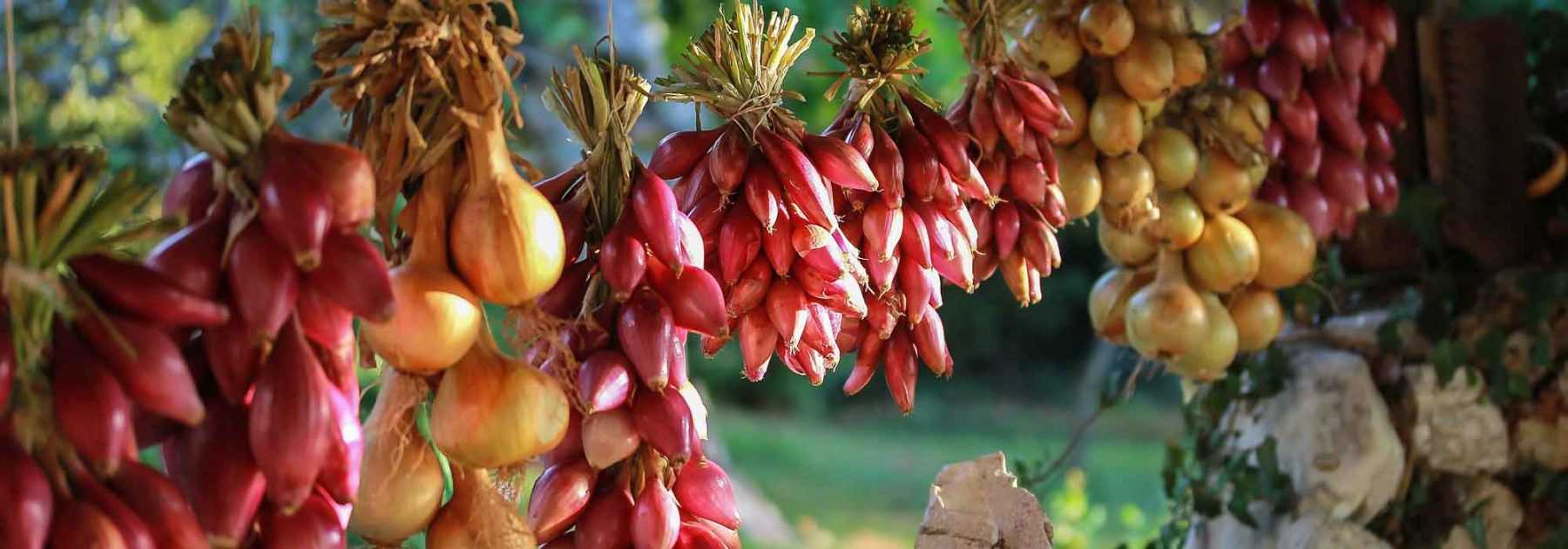
Onion: sowing, planting, growing, harvest
Contents
The onion in a few words
- The onion is a root vegetable grown as a vegetable or condiment, for its bulb and leaves.
- It can be grown in all types of soil, preferably well-drained and light, fertile but without fresh manure.
- Onions can be sown (from seed) or planted (from bulblets) in spring and autumn, depending on the variety.
- Maintenance during cultivation is limited to weeding and hoeing, with watering mainly required at the start of cultivation.
- They can be harvested green or at ripeness: White onions and some red varieties are harvested fresh, while storage onions are harvested when dry.
Our expert's word
The onion is a root vegetable from the Liliaceae family, which includes many edible and aromatic plants such as garlic, shallots, leeks, and chives. The onion is cultivated both as a vegetable and as a condiment, with its bulb being the most commonly consumed part, though its leaves and stems are also used, much like chives.
Onions are typically classified into two categories: spring onions and storage onions (also known as “keeping onions”). The former are harvested with their fresh leaves and consumed whole. These are often white onion varieties such as the ‘Blanc Printanier Parisien’ and the ‘Rouge de Florence’, both of which have a mild flesh, making them excellent for salads and raw dishes. Storage onions can also be harvested fresh, but more often they are harvested dry at full ripeness. Among these, I particularly like the ‘Stuttgart’ onion, which produces large yellow bulbs that store well. As a proud Finistère native, I must recommend the ‘Johnnies’ onion—the ‘Rosé de Roscoff’ variety even benefits from an AOC (Protected Designation of Origin) in Haut-Léon. It’s a marvel that, when raw, develops fruity aromas with a mild sharpness and a juicy, crunchy texture. When cooked, its texture becomes meltingly tender, and its sweet flavour dominates. Generally speaking, varietal choice is very important, with over 1000 varieties listed in the European catalogue. What’s particularly interesting is that there are many local varieties in France, each adapted to different terroirs. That’s why I encourage you to seek out and grow varieties from your own region.
Growing onions requires a sunny position and light soil, sufficiently well-drained and fertile but without fresh manure. Depending on the variety, onions can be sown in spring or autumn, or planted from bulblets, most often in spring. Maintenance during cultivation involves regular weeding and hoeing, as well as keeping an eye out for a fairly common pest: the onion fly.
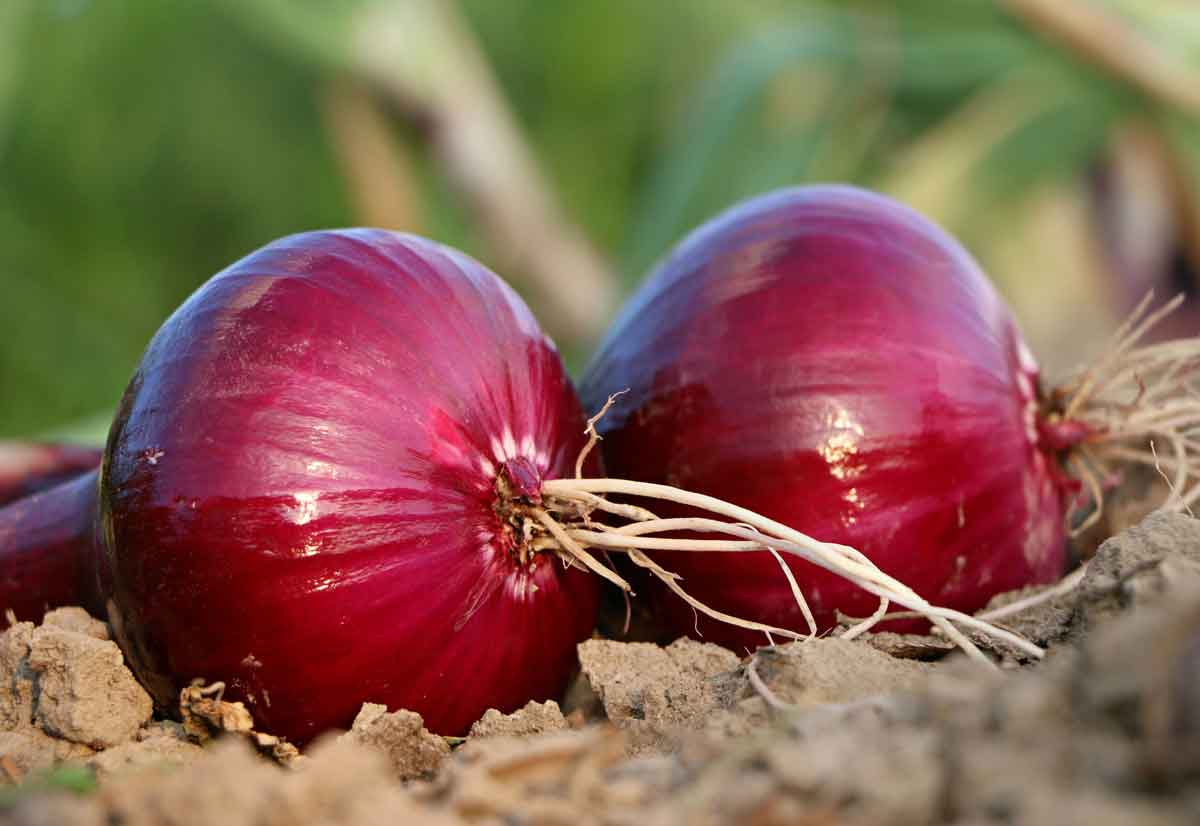
Red onions
Description and Botany
Botanical data
- Latin name Allium cepa var. cepa
- Family Amaryllidaceae or Liliaceae
- Common name Onion
- Flowering Biennial
- Height 2 years
- Exposure Sun
- Soil type loose, light, quick-draining
- Hardiness hardy
The onion is a vegetable and condiment originating from Central Asia where its closest wild relative, Allium vavilovii, can still be found today between Iran and Turkmenistan. However, it was another species, Allium pskemense, that was gathered in its wild form or collected from nature to be transplanted into gardens. Over the centuries, the onion was domesticated and adapted to various regions through migrations (India, Mesopotamia). Its presence is documented in Egypt where it was found in pharaohs’ tombs. The Romans later introduced the onion throughout Western Europe. It was during the Middle Ages that the onion reached northern France. Christopher Columbus introduced it to the Americas during his second voyage. Many new varieties were introduced, adapted and selected in France during the 19th and 20th centuries. Today, over 1000 varieties are listed in the European catalogue.
The onion, Allium cepa var. cepa, belongs to the Liliaceae family according to Cronquist’s classification or the Amaryllidaceae family according to the APG III classification. It is a herbaceous perennial plant cultivated as an annual or biennial for its bulb and leaves, harvested as spring onions. These are cylindrical and hollow, green in colour. The bulb is spherical in shape, more or less flattened, sometimes horn-shaped. It consists of a tangle of thickened leaves, called tunics, which are filled with nutrient reserves. At the centre is the terminal bud. The epidermis or outer tunic varies in colour depending on the variety – yellow (e.g. ‘Paille des Vertus’), pink (Rosé de Roscoff), red (De Brunswick), white (Printanier Parisien). Its flesh ranges from white, pink, red to purple, with a flavour varying from mild to strong. In the second year of cultivation, the onion bolts, producing a floriferous stem from the terminal bud. The flowers are small, white, and grouped in large numbers on spherical umbels. They produce black seeds with a germination period of approximately 2 years.
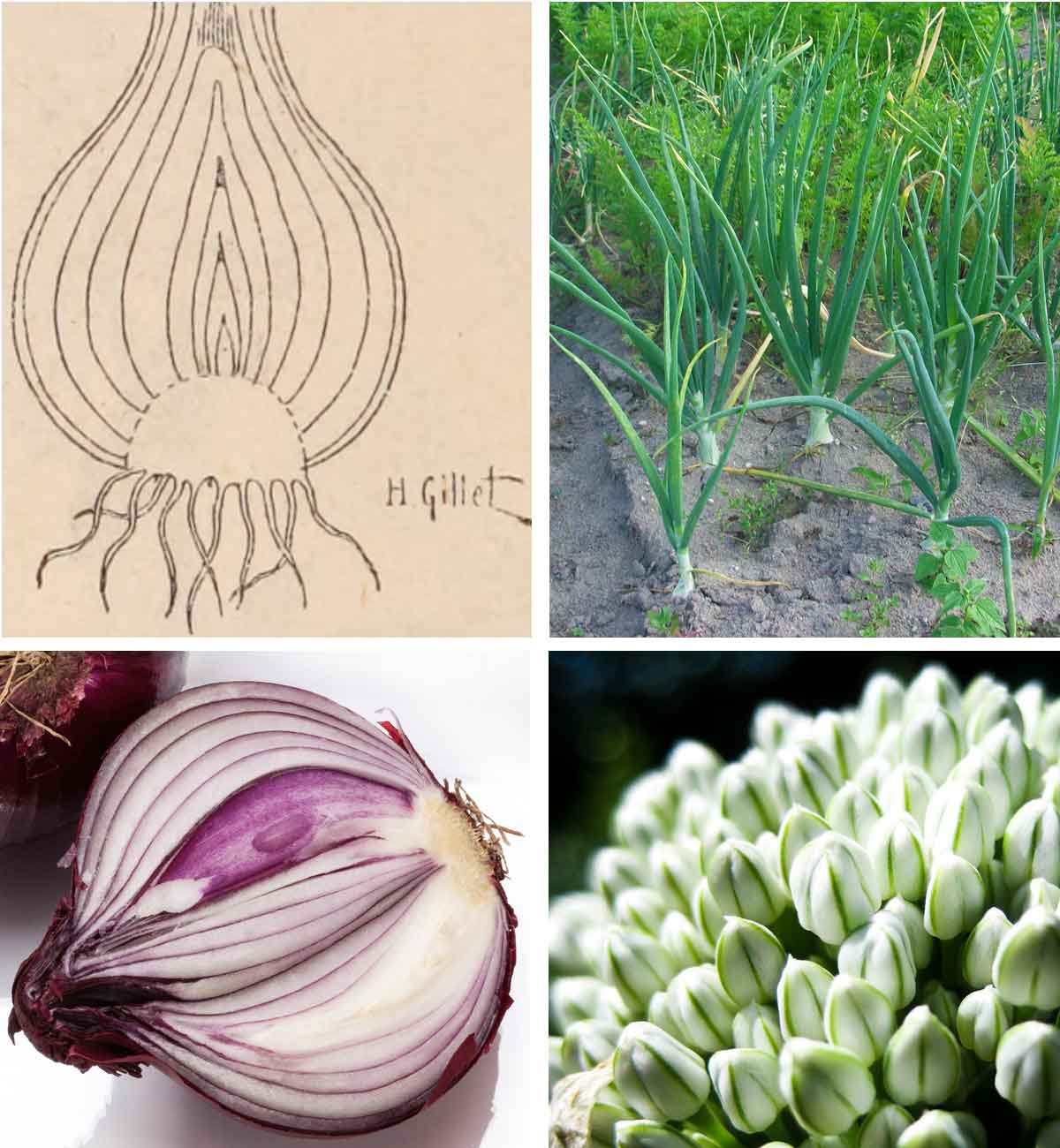
Cross-section of onion bulb – Onion in leaf, first year of cultivation – Onion flowers in second year
Read also
Planting Garlic, Shallots and OnionsOnion varieties
The choice of onion variety is important, we mainly distinguish between spring onions, eaten whole, and storage onions, mostly harvested and consumed when dry. Here is a selection of some varieties, highly appreciated by gardeners.
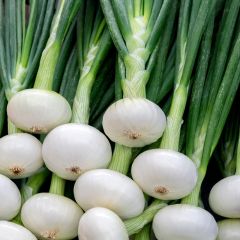
White Onion Printanier Parisien - Vilmorin Seeds
- Flowering time July to October
- Height at maturity 30 cm

Spring Onion Cipollotto White Lisbon - Allium cepa
- Height at maturity 30 cm
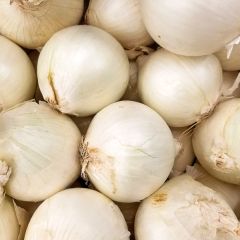
White Onion Tonda Musona
- Height at maturity 45 cm
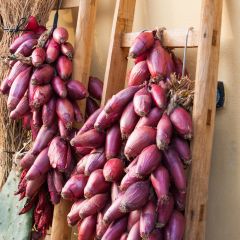
Onion Long Red Florence Simiane - Vilmorin Seeds
- Flowering time July to October
- Height at maturity 30 cm

Untreated Ailsa Craig Onion - Ferme de Sainte Marthe seeds
- Flowering time July to October
- Height at maturity 30 cm

Onion Stuttgarter Rieser - Ferme de Sainte Marthe Seeds
- Flowering time July to October
- Height at maturity 30 cm
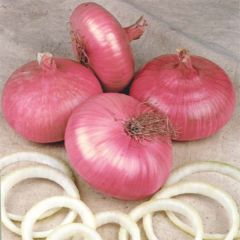
Onion Red Creole
- Height at maturity 40 cm
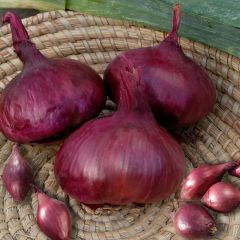
Onion Red Brunswick - Vilmorin Seeds
- Flowering time July to October
- Height at maturity 30 cm
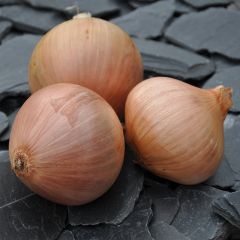
Keravel pink Onion - Allium cepa
- Height at maturity 30 cm
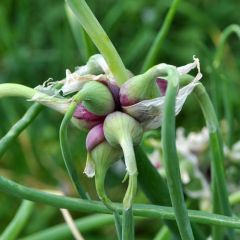
Tree onion - Allium proliferum
- Height at maturity 80 cm
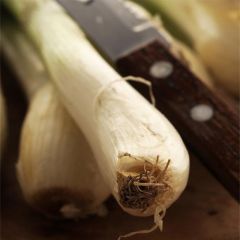
Scallion Ishikura Long White - Ferme de Sainte Marthe Seeds
- Flowering time July to October
- Height at maturity 30 cm
Discover other Onion seeds
View all →Available in 1 sizes
Available in 1 sizes
Available in 1 sizes
Available in 1 sizes
Available in 1 sizes
Available in 1 sizes
Available in 1 sizes
Available in 1 sizes
Available in 1 sizes
Available in 1 sizes
Onion sowing
When to Sow Onions?
Onion sowing takes place, depending on the variety, in spring or autumn. Spring sowing applies to coloured onions (yellow, pink and red) and some early varieties of white onions which are sown from February to April. This type of sowing is done directly in the ground.
Autumn sowing applies to white onions, which are sown at the end of summer (August-September) in seed trays or flats. They will be transplanted into open ground, either one to two months later in mild climate regions or at the end of winter around February (for all climates).
Where and How to Sow Onions?
Direct sowing in open ground requires attention during the germination period, which takes an average of 18 days. Until germination, care must be taken to keep the soil surface moist and to meticulously weed out adventive seedlings.
To sow onions directly in open ground:
- Mark out the sowing ranks by stretching a line, spacing the ranks 20 cm apart.
- Dig a furrow 2 cm deep then sow thinly, placing one seed approximately every 2 cm.
- Close the furrow and lightly firm with a rake.
- Water with a fine spray and keep the soil moist during germination.
- When the young plants have reached 5 to 10 cm (about 2 months after sowing), thin out, keeping one plant every 10 cm. The strongest removed plants can be transplanted to another growing bed.
More practical, sowing in a nursery, in seed trays or flats, allows you to select the best onions for transplanting.
To do this:
- At the end of winter, under a cold frame, sow thinly in rows or in a seed tray (or flat), sow thinly by broadcasting.
- Cover with one centimetre of soil or compost and firm down.
- Water gently, using a hand sprayer or the fine rose of a watering can.
Transplanting Onions
When the young plants from nursery or seed tray (or flat) sowing reach at least 15 cm in height, it is time to transplant them to their final position.
Transplanting onions is done as follows:
- “Dress” the plants if necessary: this involves keeping about 2 cm of roots and cutting a small piece of leaf.
- Plant the onion shallowly, just 2 to 3 cm deep then firm in well! Firming means pressing the soil firmly around the young plant; to do this, use a dibber which you push into the soil around the seedling, then bring the soil back towards the roots to ensure it is well firmed. It is also possible to dip (soak them in a mixture of soil and water) the roots before transplanting.
- Water gently after transplanting.
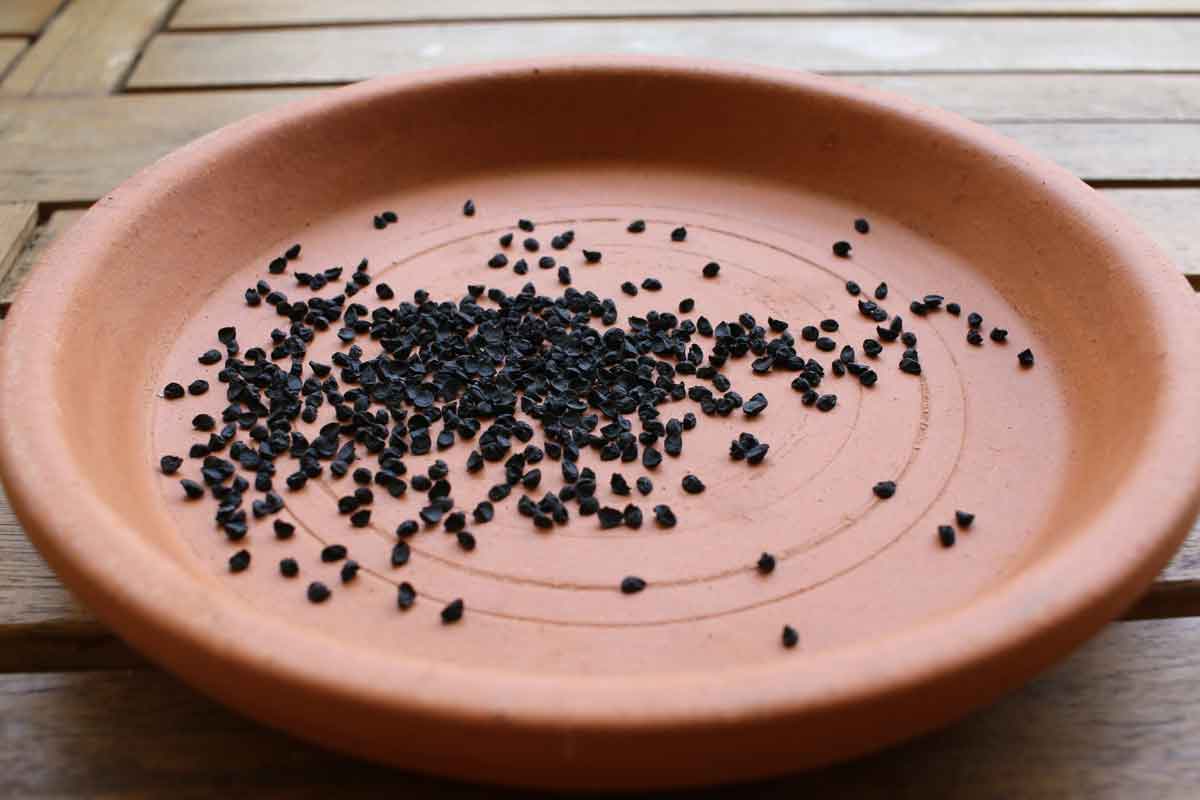
Onion Seeds – Photo A. Gourmelen
Planting onions
Planting onions involves bulblets. Onions grown using this method are generally larger but don’t keep as well as those from direct sowing. The choice of variety is also more limited! However, they have the advantage of being harvestable earlier in the year.
When to plant onion bulblets?
Onion bulblets should be planted from late February to early April, depending on your climate.
How to plant onion bulblets?
Planting bulblets requires slightly wider spacing than direct sowing:
- Within the rank, allow 12 to 15 cm between each bulblet, depending on the expected growth of the variety
- Space ranks 25 cm apart
To plant your onion bulblets in the vegetable garden:
- Prepare your bed as for conventional sowing
- Mark your ranks using a garden line (a straight rank is always easier to weed)
- Plant each bulblet 2 to 3 cm deep, with the tip just showing.
- Water if needed.
Cultivation, care and companion planting
Onions thrive in sunny positions, they grow well in all types of soil but prefer well-drained and light soils, as they dislike waterlogged conditions. Taking the two French PDOs as examples: the geographical area of the Roscoff Onion has loamy, loose, deep and fertile soil with good water retention (with this specific characteristic and the climate, it doesn’t require irrigation). The Sweet Cévennes Onion, cultivated on the famous terraces, grows in light, free-draining soil over a base of acidic rock.
Onions grow ideally in fertile soil but the manure must not be too fresh! Well-rotted compost applied in autumn for spring sowing or planting will be ideal. Onions are sensitive to excess nitrogen, so we advise avoiding any manure application before sowing or planting them after green manures, as this would increase the risk of rot and poor storage.
To limit disease risks, where possible, implement a crop rotation of around 5 years before growing onions or vegetables from the same family (garlic, shallots, leeks) again.
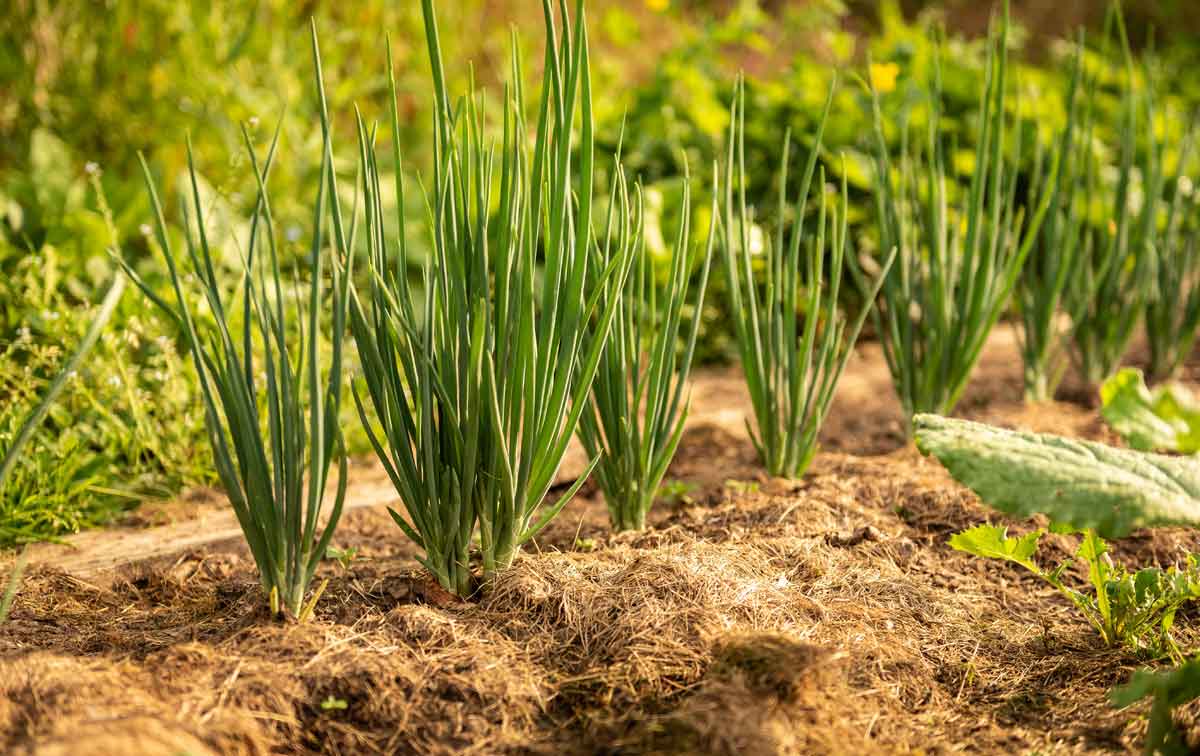
Growing onions
For companion planting, alternate rows of onions and carrots to mutually deter the carrot fly and onion fly. Additionally, onions thrive alongside beetroot and lettuces. Strawberries will also appreciate their presence.
Maintenance tasks involve regular weeding and hoeing, especially early in the growing season. Onions are sensitive to moisture: watering should be kept to a minimum, and mainly applied during sowing and transplanting.
You can certainly mulch your onion rows. However, remember they dislike both excess nitrogen and moisture: never use fresh grass clippings but mulch with dry materials like straw, pre-dried grass clippings or dried adventives.
Onion Diseases and Pests
The Onion Fly
If you notice some individuals in your onion patch yellowing and drying out prematurely, there’s a good chance it’s the onion fly. Dig up the affected young plants and check if they aren’t being devoured by the larvae of this fly at the base of the bulb!
The onion fly, Delia antiqua, resembles a housefly. It lays its eggs in the soil at the collar of the onion. After hatching, the maggots feed on the onion bulb. They devour the young plant at the collar, cutting off the sap flow, causing the leaves to yellow and then die. If the attack is mild, it also provides an entry point for moulds, which can take over and kill the young plants. Once the larvae are well developed (they measure 8 mm at the end of the larval stage), they easily move from one young plant to another. This is why it’s important to remove affected plants as soon as they are detected.
How to prevent attacks by this fly?
- Avoid spraying nettle manure on onions and plants from the same family. Not only do they dislike excess nitrogen, but the smell of this manure attracts the onion fly!
- The onion fly dislikes the strong smell of carrots, alternate your rows of onions with rows of carrots.
- Insect netting with fine mesh is a good solution. As it is generally costly, use it if this is a recurring problem in your vegetable garden.
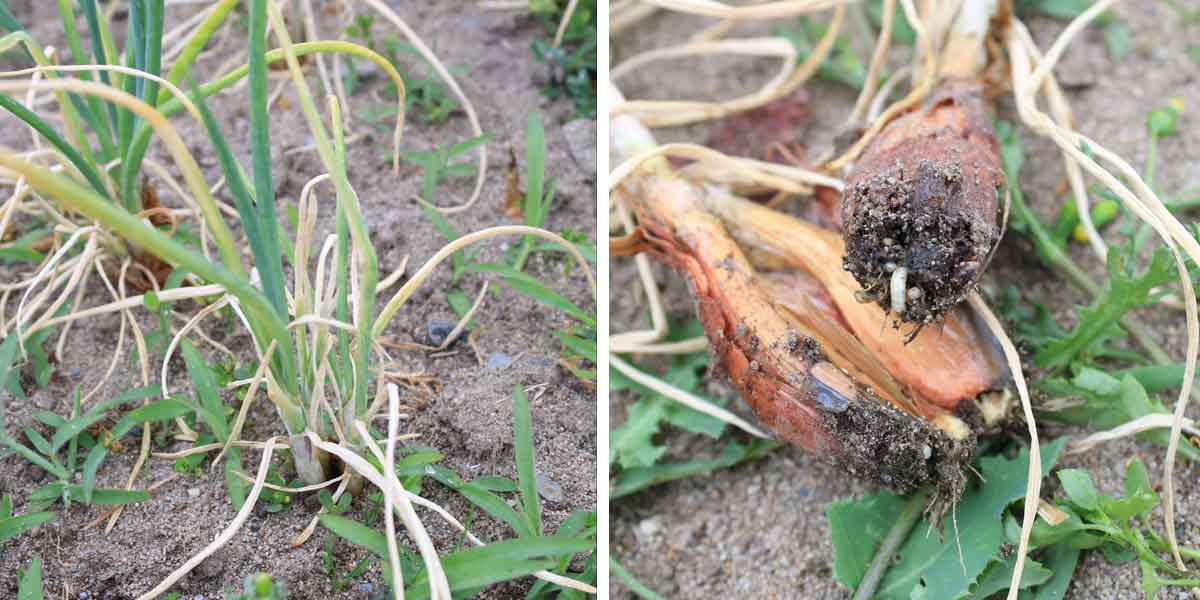
Poor condition of shallot young plants (similar symptoms on onions), digging up the bulbs reveals the maggots at work. Photographs by A. Gourmelen
Onion Downy Mildew
Onion downy mildew is caused by a fungus, Peronospora destructor, whose species name is very telling! The symptoms caused by this fungus include brown spots and a greyish-purple felt on the leaves. It spreads quickly and leads to the complete drying out of the foliage. Damage can be significant if conditions remain favourable for the fungus’s development. The conditions for P. destructor development are high humidity and mild temperatures, with 15 to 17°C being its optimal range. These conditions are mainly met in spring. Once temperatures rise above 25°C, the fungus dies.
→ Learn more about onion diseases and parasites in our advice sheet.
Harvest and storage
Spring onions (white, some red varieties) are harvested in spring when the foliage is still green. Storage onions (yellow, red and pink varieties) are harvested in summer when the stems have completely dried out and lie flat on the soil. Gently lift them and allow them to dry for two to three days directly on the ground in the sun. Remove any excess dried soil by lightly rubbing them.
Storage onions can be kept for several months under proper conditions. If you’ve kept the stems, you can braid them and hang them up. Otherwise, cut off the leaves and store the onions in a dark, cool, dry and well-ventilated place. First check that they haven’t been bruised to avoid rot which could spoil the entire harvest. Over the months, inspect and remove any mouldy onions – you can usually tell by the smell.
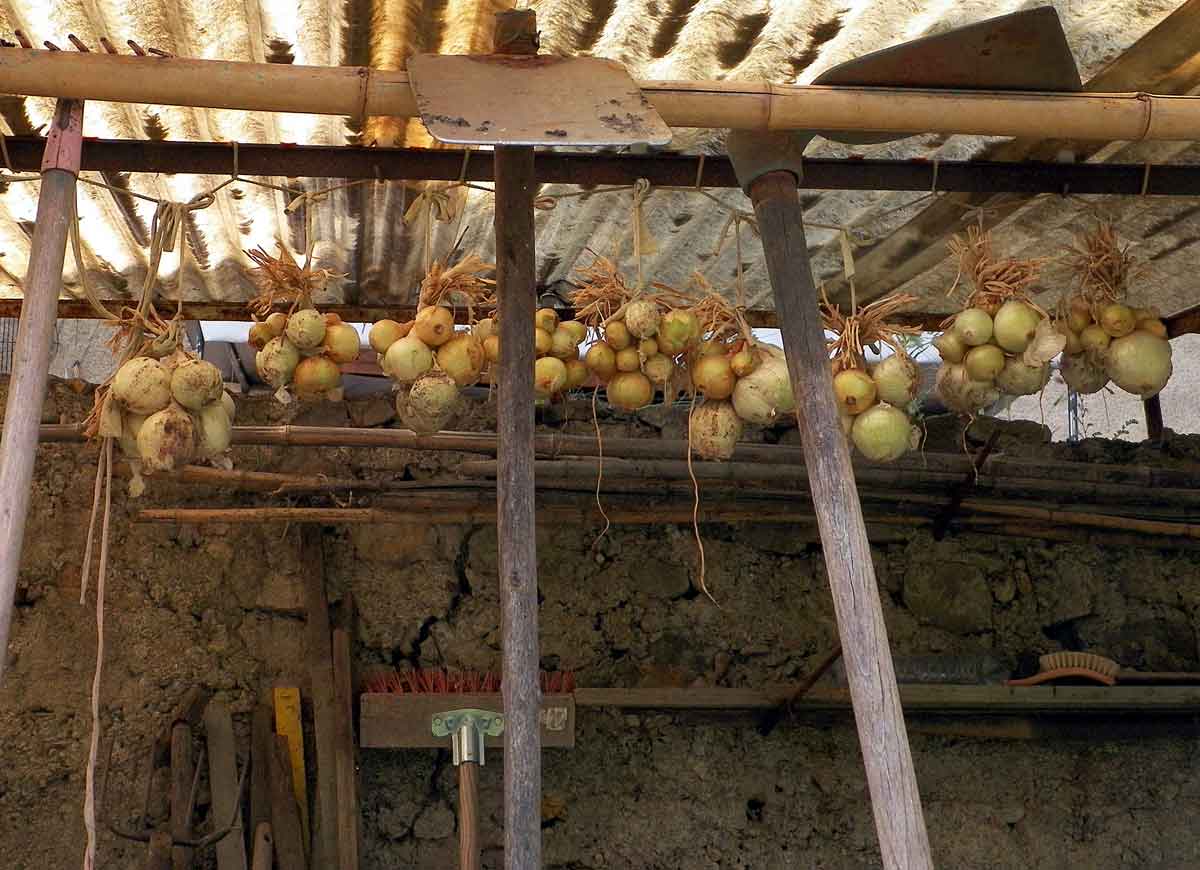
Braided and hung onions for storage
Uses and Benefits
White onions can be eaten raw or cooked; they are often more digestible when cooked and develop a sweeter flavour. Storage onions are mostly consumed cooked. To avoid crying while cutting an onion, you can peel it under running tap water or in a basin of water.
Onions are rich in sulphur compounds, fibre, iron and selenium, vitamin C, and finally antioxidants (especially for coloured onions rich in anthocyanins).
The sulphur compounds are responsible for their slightly indigestible effect and provide the pungent flavour (the same one that makes you cry), but they promote blood circulation and help lower cholesterol levels in the blood. Selenium is a very powerful antioxidant trace element. Onions boost immunity and protect against microbes. Onions work in synergy with iron-rich foods, allowing better absorption of this trace element.
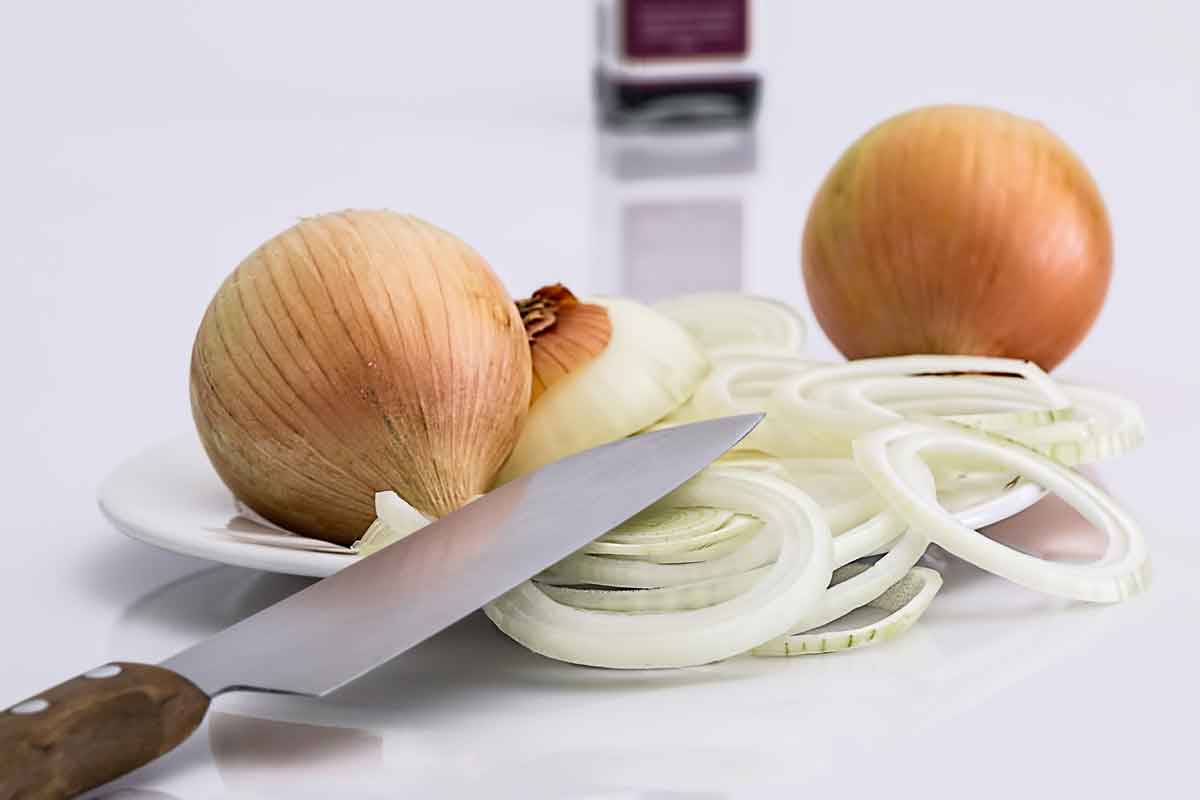
Useful resources
- Discover our range of onions available as seeds or bulblets to plant.
- This article about the two onions with AOC status in France on the Ministry of Agriculture’s website.
- Our advice sheet: Diseases and parasitic pests affecting onions
- Rocambole garlic and onions: how to successfully grow these perennial vegetables
- Pascale explains the benefits of using onion skin decoction in the garden
Frequently asked questions
-
Why are my onion leaves curling?
Sometimes the leaves of onions curl and turn yellow, which is a symptom of onion stem nematode or stem and bulb eelworm. The bulbs are also affected, becoming deformed and developing lesions. This is caused by a nematode, Ditylenchus dipsaci, a microscopic worm that thrives in cool, damp conditions. Infected onions should be removed as soon as the first symptoms appear. As a preventive measure, use seeds (or bulbs) with guaranteed sanitary quality.
-
Can you plant sprouted onions?
Sometimes you may find sprouted onions in the pantry. If the sprout is just emerging, you can still consume them by removing the sprout. Otherwise, you can plant them to harvest some fresh leaves. However, since the onion is a biennial plant, it will produce a flowering stem, bloom, and then set seed which you can harvest and resow the following spring.
-
- Subscribe!
- Contents
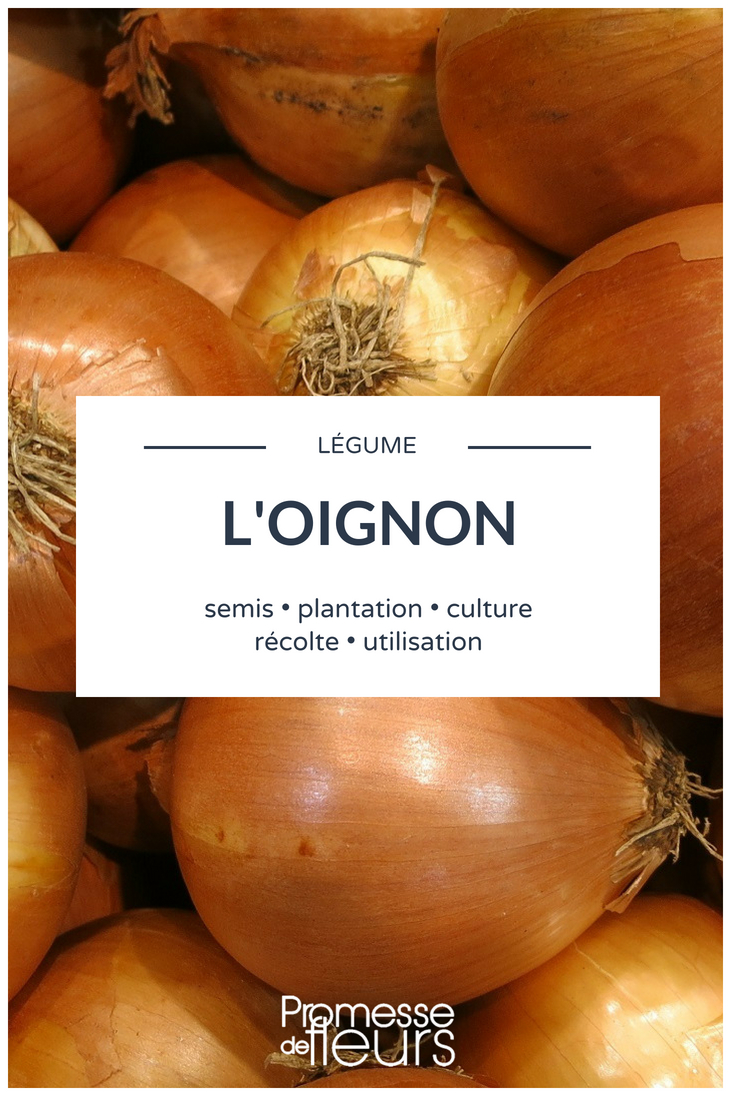


































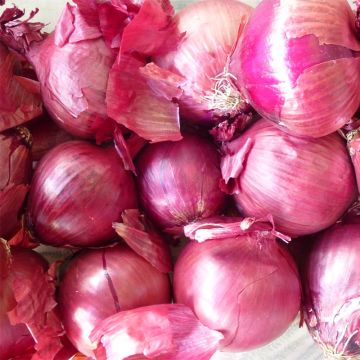

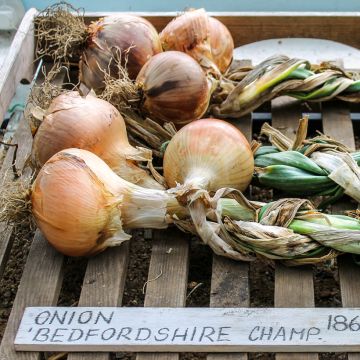

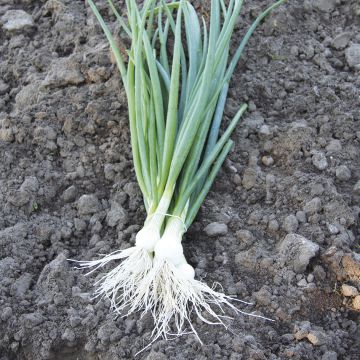
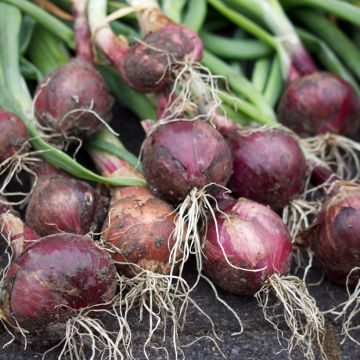
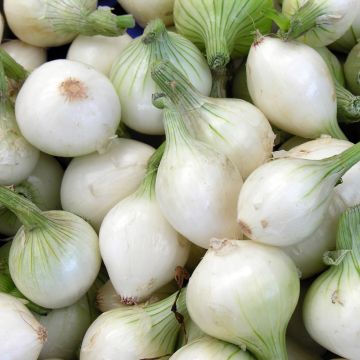
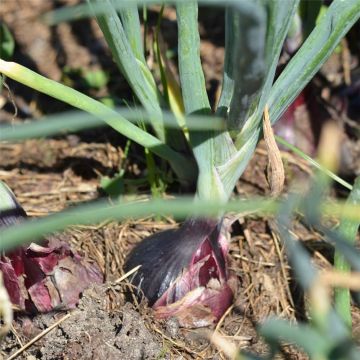
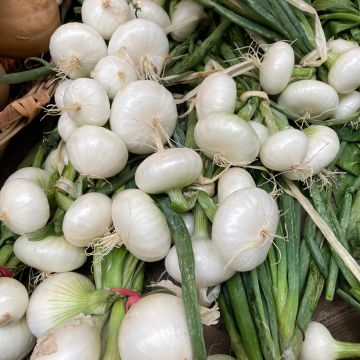
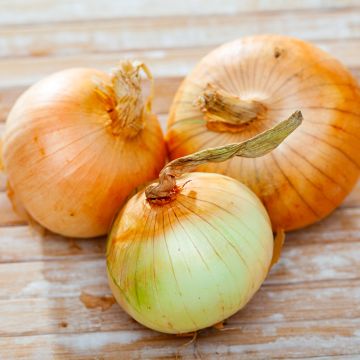
Comments